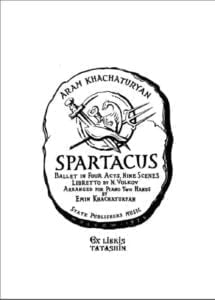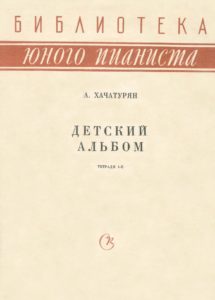Khachaturian – Lullaby from Gayane (piano solo arrangement) with sheet music
Aram Il’yich Khachaturian (Russian: Арам Ильич Хачатурян, Armenian: Արամ Խաչատրյան, Aram Xačatryan; 6 June 1903 – 1 May 1978) was a Soviet Armenian composer and conductor. He is considered one of the leading Soviet composers.

Born and raised in Tbilisi, the multicultural capital of Georgia, Khachaturian moved to Moscow in 1921 following the Sovietization of the Caucasus. Without prior music training, he enrolled in the Gnessin Musical Institute, subsequently studying at the Moscow Conservatory in the class of Nikolai Myaskovsky, among others.
His first major work, the Piano Concerto (1936), popularized his name within and outside the Soviet Union. It was followed by the Violin Concerto (1940) and the Cello Concerto (1946). His other significant compositions include the Masquerade Suite (1941), the Anthem of the Armenian SSR (1944), three symphonies (1935, 1943, 1947), and around 25 film scores. Khachaturian is best known for his ballet music—Gayane (1942) and Spartacus (1954). His most popular piece, the “Sabre Dance” from Gayane, has been used extensively in popular culture and has been covered by a number of musicians worldwide.
His style is “characterized by colorful harmonies, captivating rhythms, virtuosity, improvisations, and sensuous melodies”. During most of his career, Khachaturian was approved by the Soviet government and held several high posts in the Union of Soviet Composers from the late 1930s, although he joined the Communist Party only in 1943. Along with Sergei Prokofiev and Dmitri Shostakovich, he was officially denounced as a “formalist” and his music dubbed “anti-people” in 1948 but was restored later that year. After 1950 he taught at the Gnessin Institute and the Moscow Conservatory and turned to conducting.
He traveled to Europe, Latin America and the United States with concerts of his own works. In 1957 Khachaturian became the Secretary of the Union of Soviet Composers, a position he held until his death. Khachaturian composed the first Armenian ballet music, symphony, concerto, and film score. He is considered the most renowned Armenian composer of the 20th century.
While following the established musical traditions of Russia, he broadly used Armenian and, to lesser extent, Caucasian, Eastern and Central European, and Middle Eastern peoples’ folk music in his works. He is highly regarded in Armenia, where he is considered a “national treasure”. Gayane (Gayaneh or Gayne, the e is pronounced; Armenian: Գայանե) is a four-act ballet with music by Aram Khachaturian.
Originally composed in or before 1939, when it was first produced (in Yerevan) as Happiness. Revised in 1941–42 to a libretto by Konstantin Derzhavin and with choreography by Nina Aleksandrovna Anisimova (Derzhavin’s wife), the score was revised in 1952 and in 1957, with a new plot. The stage design was by Nathan Altman (scenery) and Tatyana Bruni (costumes).
The first performance took place on 9 December 1942, staged by the Kirov Ballet while in Perm, Russia, during the Second World War evacuation, and was broadcast on the radio.The principal dancers were: Natalia Dudinskaya (Gayane), Nikolai Zubkovsky (Karen), Konstantin Sergeyev (Armen), Tatanya Vecheslova (Nune), and Boris Shavrov (Giko). The conductor was Pavel Feldt.The most famous parts of the ballet are the “Sabre Dance”, which has been performed by many (including pop artists), and the “Adagio”, which featured prominently in Stanley Kubrick’s film 2001: A Space Odyssey.
Khachaturian’s original Gayane was the story of a young Armenian woman whose patriotic convictions conflict with her personal feelings on discovering her husband’s treason. In later years the plot was modified several times, the resultant story emphasizing romance over nationalistic zeal.
The ballet Gayane was modestly successful when danced before Joseph Stalin;performances outside the USSR have been infrequent. At the time, it was understood that the simple libretto was a necessary backdrop for the dancing, which was splendidly staged and choreographed by Anisimova, who danced in the original production. Choreographically, Anisimova thought in character dancing terms; she knew much classical dance.

Excerpts from Gayane are performed by dance companies and dance schools, especially the wedding in the second act: wonderful duets and variations for Gayane and Kazakov, her lover. The choreography was unusual for its time—classical and folk dance combined—especially the stylized use of arms and hands from the folkloric Armenian culture that is the ballet’s background.
The collective farm’s ethnic diversity is the backdrop for each part of the music (adagio arrangements, lively Armenian and Caucasian tunes) and for the compelling tale of love between a couple from between different social classes.
The premiere cast included Natalia Dudinskaya and Konstantin Sergeyev, then leading figures in Leningrad ballet. Nina Anisimova danced the part of an Armenian girl who is an image and symbol of socialist labour: she works hard, she knows how to produce the most from the fields, but she also knows how to enjoy life, spending her free time dancing and laughing.
The suite of dances in the second act reflects the nationalities of the Soviet Union. At the time, the Republic of Armenia was one of 15 republics within the Union. For that, Anisimova created the famous “Sabre Dance” that, when performed as a musical extract, became a showpiece for many dance companies.
The style of movement in the dance is unusual and unexpected for character dance—unusual bends of the body, inventive positions of the arms, not from the classical moves, the overall structure of the body is not balletic, but, most of all, in keeping with Khachaturian’s music, the choreography is temperamental, like Anisimova herself.
When critics analysed Gayane, they saw that, in strict ballet terms, it is not completely successful as a whole, because of its naïve libretto and its overtly social emphasis, yet, choreographers, critics, and historians persuaded the Kirov Theatre to profitably stage excerpts of the ballet.
The “Variation of Gayane”, the “Variation of Giko”, and the character dances were effectively done and subsequently danced as gala pieces. After its premiere in Perm, Anisimova twice restaged Gayane for the Kirov and after revision, the 1952 version stands as the definitive version of Gayane.
In the end, Nina Anisimova proved that character dancing endures and should be included in the world of classical ballet. The dance in Gayane did not follow the Petipa tradition, for example Swan Lake, wherein the audience is treated to national dance in discrete divertissements of “dances of le salon”, in Petipa’s words; in contrast, the dance in Gayane, by force of character, is felt throughout the ballet; it is a natural part of the people and of their history.
In time, the ballet helped choreographers understand the importance of choreographic art in Russia, combining character dance with classical and mime traditions. Gayane is an excellent example of character dance and ballet combined; its artistic value to twentieth-century Soviet choreography is significant.
